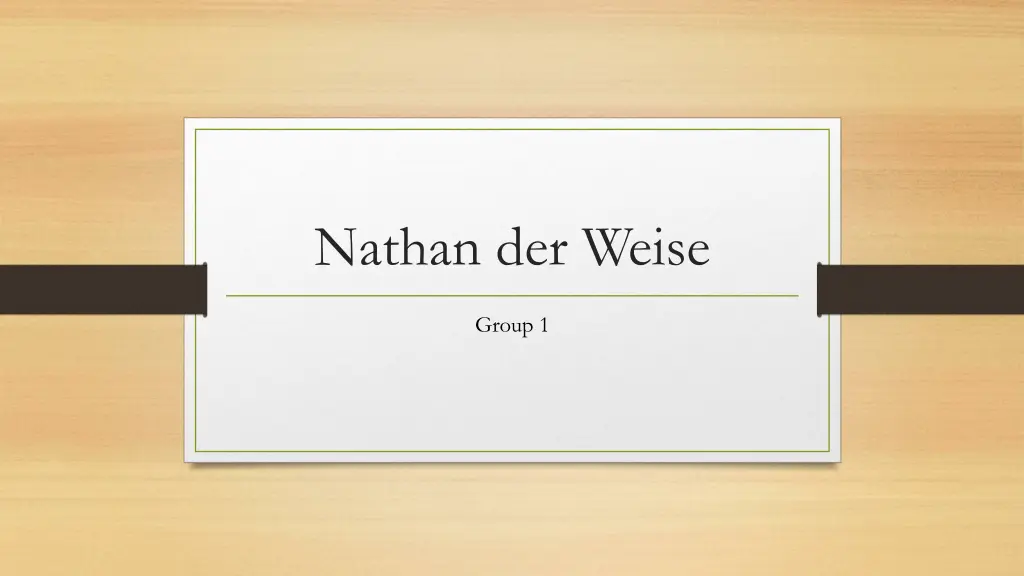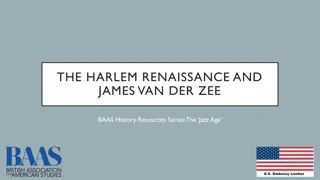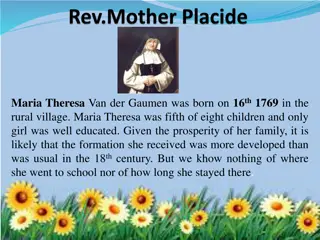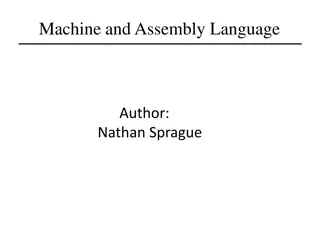
Challenging Stereotypes of Race and Religion in Nathan der Weise
Explore how Lessing challenges stereotypes of race and religion in "Nathan der Weise" through the characters of Nathan, Saladin, and Tempelherr. The play examines societal perceptions and prejudices, showcasing characters who both conform to and defy expectations based on their faith and background, ultimately promoting understanding and unity among different religious groups.
Download Presentation

Please find below an Image/Link to download the presentation.
The content on the website is provided AS IS for your information and personal use only. It may not be sold, licensed, or shared on other websites without obtaining consent from the author. If you encounter any issues during the download, it is possible that the publisher has removed the file from their server.
You are allowed to download the files provided on this website for personal or commercial use, subject to the condition that they are used lawfully. All files are the property of their respective owners.
The content on the website is provided AS IS for your information and personal use only. It may not be sold, licensed, or shared on other websites without obtaining consent from the author.
E N D
Presentation Transcript
Nathan der Weise Group 1
To what extent does Lessing deal with stereotypes of race and religion in Nathan der Weise? Nathan Nathan s character partly conforms to and partly challenges society s stereotypes of Jews. Nathan is wealthy, but unlike other stereotypical Jews such as Shakespeare s Shylock, Nathan s wealth does not lead him into foolish, selfish decisions. Rather he is wise and enlightened. Templar says to Daja, Seinem Volk ist reich und weise, vielleich das N mliche Nathan decides not to lend money to Saladin, at the expense of appearing a Stockjude , far better than giving Saladin money, he imparts his knowledge through the Ringparabel. Nathan is a wealthy man and has no reason to be ashamed of his wealth, for he makes wise and generous use of it (Lamport, Lessing and the drama, p205 ) Nathan is a lone character no unshakeable support network as his real family were slaughtered by Christians and even Daja, although brought up to revere God does not seem to belong to his Jewish religion. Saladin is surrounded by muslim family and friends (Sittah, Al Hafi/wariors/slaves etc.). Tempelherr is also in the company of other Christians (Daja and Brother Bonafides) and can seek council from the Patriarch . YET it is Nathan (the lone Jew figure), who unites the other characters at the end. He defies his stereotypical role in society.
To what extent does Lessing deal with stereotypes of race and religion in Nathan der Weise? Saladin Similarly, Saladin in part conforms to his stereotype. He IS a warrior who has put numerous Templars to death in his pursuit of power. But, in the case of Templelherr he rejects his religious beliefs and merciless habits, on the unusual (arguably weak) basis of perhaps seeing something of his deceased brother in him. He also gives Nathan the chance to demonstrate his beliefs and character, defying Al Hafi s warning that Saladin never listens to advice, as he says to Nathan, so sage mir doch einmal- /Was fuer ein Glaube, was fuer ein Gesetzt/Hat dir am meisten eingeleuchtet?
To what extent does Lessing deal with stereotypes of race and religion in Nathan der Weise? Tempelherr/Patriarch Interestingly the most negative portrayal of the three major religions. Christianity is presented in the least stereotypical light for its day, in which it would have been largely hailed as the only good and true religion by most Germans e.g. Johann Goeze and others like him who inspired the play. Tempelherr is portrayed as stubborn, rude and unforgiving (far from Christ-like) in his actions towards Recha, Nathan and even Daja who is a Christian. (She says of her attempts to talk to him Er war zu unsrer Bitte taub; Und goss so bittern Spott auf mich besonders l. 118) Templar is a weak character, who, unlike Nathan and Saladin is not a good judge of character- he does not trust Nathan, even after they are friends and goes to the Patriarch and reveals that Nathan has been raising Recha a Jew, when she is (supposedly) by birth a Christian.
To what extent does Lessing deal with stereotypes of race and religion in Nathan der Weise? On the subject of racial-religious stereotypes . As the three principal character representatives for Judaism, Islam and Christianity Nathan, Saladin and Tempelherr, (along with the other characters belonging to the 3 religious groups) initially appear to belong to the stereotypically accurate ethnicity. (Caucasian/European Christian, Kurdish Muslim, Israeli Jew) However, as it turns out, the Christian Tempelherr had a Kurdish father and is the nephew of Saladin and the brother of the Jewish-raised Recha. Thus proving that no man can be born a religion it is a question of nurture over nature! The biological intermingling of different ethnic groupings here brings all of the characters to recognise their common humanity which should stand above any religious differences. In this way Lessing was ahead of his time in a society which knew nothing about modern theories around polygenics (the belief that there is more than one race of man). The patriarch demonstrates a shameful representative of a Christian (no doubt intended to shock the largely Christian audience), as he emphasises the destructiveness of the belief that people are born belonging to a certain religion, as a result of their parents: a stickler for the letter of the law at its most inhuman, insisting that der Jude wird verbrannt (Lamport, Lessing and the drama, p209)
How are Race and Religion connected in Nathan der Weise? Race and Religion clearly play a key role in building tension and conflict between the characters, and it is only by casting aside any preconceptions about religious and racial identity that the characters can resolve the tensions that have run through the play. Characters such as Nathan and the Templar conform to their racial and religious stereotypes in terms of the treatment they receive Nathan (Jew) suffers from discrimination, whilst the Templar (European Christian) participates in crusades and is also responsible for much of the anti-Semitism directed towards Nathan (especially at the beginning) The very fact that Recha is a Christian child born to Christian parents indicates that Race and Religion need not be a mutually exclusive concept implying instead that religious identity (and identity in general) is constructed rather than predetermined. Saladin does not agree with the religions becoming identical in the ring parable, saying that (Line 1970) he thinks that the religions Nathan mentions can be distinguished from the clothes they wear, the food they eat etc (and thus, presumably, race).
What, if anything does Lessing have to say about Gender in Nathan der Weise? Females: Recha is an undervalued woman and a figure of fragile sensibility. She projects her father s values and has little control over her fate. We learn though her infatuation of the Christian cause that Daja is obsessive and sometimes irrational. They are both therefore identified as vulnerable and dependent, characteristics that are typical of their gender. Infatuation and emotional thinking is solely evident among the females in the play. A close reading of the play will aid this analysis: Ach! die arme Frau- ich sag dir s ja- Ist eine Christin [ ] Ist eine von den Schwaermerinnen, die Den allgemeinen, einzig wahren Weg Nach Gott zu wissen waehnen! [6: 3585-3589] Recha calls her friend arm , showing that she pities her for her said infatuation for the Christian cause. She identifies her by calling her a frau and not by her name, thereby binding the two ideas of weakness and her gender together.
What, if anything does Lessing have to say about Gender in Nathan der Weise? Males: Nathan, on the other hand, is generous, level-headed and loving and Recha elevates the heroic Templar to a god- like status by being portrayed as a guarding angel: ich hab einen Engel Von Angesicht zu Angesicht gesehen; Und meinen Engel [1: 198-200] Recha s emotion blinds her judgement here, and can be seen as a weakness of her gender and a frailty of mind, something that is not seen among the males in the play. The idealisation of the Templar highlights the relationship between the two genders: one of admiration/ infatuation and of (almost sublime) superiority. It is no accident here that a male is granted god-like status; it is to signify the disparity between the influences of the sexes.
What, if anything does Lessing have to say about Gender in Nathan der Weise? Sittah and Saladin Sittah is seen playing chess with Saladin, perhaps the most intellectual board game of all. This is not how a woman would typically be portrayed in society. Mother, carer, domestic, etc. Perhaps because of her class she is very wealthy, as Saladin s sister. What s more, she appears to be winning at the start of the scene, and pointing out the mistakes he is making, so for a moment it seems as though the woman is intellectually superior to the man. [87-88] However, this idea is such reversed when Sittah accused Saladin of letting her win. This then represents women as the inferior again, implying that Saladin could win if he were trying, but he doesn t want to win and is therefore in complete control of the situation. Furthermore, Sittah enjoys the game a lot less after accusing him of losing on purpose. [807-813] During the game, the queen is brought up. Saladin s queen is in jeopardy, but he decides that the queen was never so important to him anyway. Sittah s attempts to find a way of saving the queen, but he dismisses it without the bat of an eyelid. Sittah then remarks on how awfully he treats his queen. [821-829] Saladin sends Sittah away when he must attend to important business, such as speaking with Nathan and the Templar. Women not involved in serious discussions and decisions. [1791; 2647]
What form does Lessing's cosmopolitan vision take - and it what ways might one argue it is flawed? Cosmopolitan: Pertinent or common to the whole world. Lessing s cosmopolitan view in Nathan der Weise is formed by the realisation of the 3 main characters all of different religious backgrounds that they are in fact not all that different. Turnings points towards cosmopolitanism: After seeing Nathan shed a tear onto his cloak, the Templar accepts Nathan s offer of friendship and throws away any previous grudge he had against Jews. Perhaps the fact he saw Nathan show some true emotion changed his preconception about Jews and realised that they are in fact just like anyone else. Eine Tr ne fiel darauf Nathan, P53, l. 1252; Wir m ssen, m ssen Freunde werden - Templar, P55, l. 1319. You could argue that Saladin is already quite the cosmopolite in the fact that he saved the Templar from death, showing respect to someone of another culture. However this was mainly on the basis that the Templar looks like Saladin s deceased brother Assad. Therefore the second turning point could take place following the ring parable of Nathan. Saladin admires this story greatly and begins to come to terms with ideas of acceptance and tolerance, all coherent to cosmopolitanism. Saladin (der auf ihn zust rzt, und seine Hand ergreift, die er bis zu Ende nicht wieder fahren l sst). P83. This is quite a powerful scene in understanding Saladin s respect and admiration for Nathan and his story. The fact that a Muslim leader takes a Jewish merchant s hand and won t let go is declaration of the bond now shared between the characters. A similar bond is demonstrated when Saladin offers his hand to the Templar who takes it when Saladin learns that they are blood relatives. [Pp117-118, ll. 2694-2695]
What form does Lessing's cosmopolitan vision take - and it what ways might one argue it is flawed? Lessing s form of cosmopolitanism takes shape through the formation of friendships between Nathan, Saladin and the Templar. These friendships and acceptances of difference take place in the final act where the characters discover they are in fact blood related. Therefore any notions of cosmopolitanism displayed by the characters prior to this act can be judged as genuine. However, it is difficult to judge whether the affection shown in the final scene is due to tolerance and acceptance of other cultures and religions, or simply due to familial relations. It could be argued that there is enough evidence before the final scene to justify that Lessing s view of cosmopolitanism in Nathan der Weise is not flawed.






















